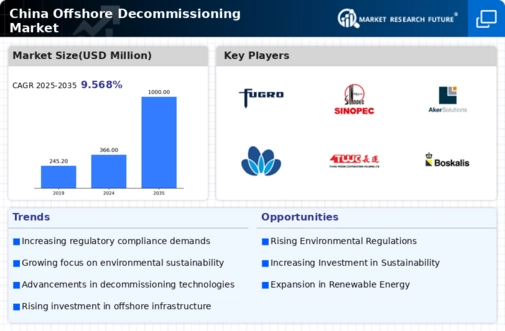Aging Infrastructure
The aging infrastructure of offshore oil and gas facilities in China serves as a significant driver for the offshore decommissioning market. Many platforms, some operational for over 30 years, are reaching the end of their productive lives. The Chinese government has recognized the need for decommissioning these outdated structures to mitigate environmental risks and ensure safety. Reports indicate that by 2030, approximately 40% of offshore platforms may require decommissioning, creating a substantial market opportunity. This trend is further exacerbated by the increasing costs associated with maintaining aging infrastructure, which can lead to operational inefficiencies. Consequently, the offshore decommissioning market is poised for growth as companies seek to address these challenges.
Regulatory Framework Evolution
The evolution of regulatory frameworks in China is a pivotal driver for the offshore decommissioning market. As the government enforces stricter environmental regulations, companies are compelled to adhere to these standards, which often necessitates decommissioning aging offshore structures. The Ministry of Ecology and Environment has introduced guidelines that mandate the safe disposal of offshore assets, thereby increasing the demand for decommissioning services. In 2025, it is estimated that compliance costs could account for up to 30% of total decommissioning expenses, highlighting the financial implications of regulatory adherence. This evolving landscape not only drives the need for decommissioning but also encourages investment in sustainable practices within the offshore decommissioning market.
Economic Transition and Energy Policy
China's economic transition and evolving energy policies are driving the offshore decommissioning market. As the country shifts towards cleaner energy sources, there is a growing emphasis on decommissioning fossil fuel-based offshore facilities. The government has set ambitious targets for renewable energy adoption, which may lead to the decommissioning of older oil and gas platforms. By 2025, it is anticipated that the decommissioning of non-compliant facilities could represent a market worth over $5 billion. This transition not only aligns with national energy goals but also opens avenues for investment in renewable energy projects, thereby reshaping the landscape of the offshore decommissioning market.
Investment in Decommissioning Technologies
Investment in advanced decommissioning technologies is emerging as a crucial driver for the offshore decommissioning market. As companies in China seek to enhance efficiency and reduce costs, they are increasingly adopting innovative technologies such as robotics and automated systems. These advancements not only streamline the decommissioning process but also minimize environmental impact. In 2025, it is projected that investments in technology could account for up to 25% of total decommissioning budgets. This shift towards technological integration reflects a broader trend within the offshore decommissioning market, where companies are prioritizing sustainable and efficient practices to meet regulatory demands and public expectations.
Public Awareness and Environmental Concerns
Increasing public awareness and environmental concerns are significantly influencing the offshore decommissioning market. As citizens become more informed about the ecological impacts of offshore activities, there is heightened pressure on companies to responsibly decommission aging structures. This societal shift is prompting regulatory bodies to enforce stricter decommissioning protocols, which could lead to increased operational costs. In 2025, it is estimated that public sentiment could drive a 20% increase in demand for environmentally responsible decommissioning practices. Consequently, companies are compelled to invest in sustainable solutions, thereby shaping the future of the offshore decommissioning market.

















Leave a Comment